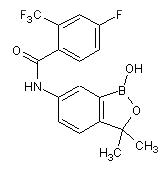CurlySMILES has been designed as a chemical language to formulate
molecular structures and material architectures independent
from natural language and chemical terminology. Yet, it is
sometimes desirable to tie a CurlySMILES notation together
with a common name or a specific term. The
annotation dictionary keys,
cha, chc
and chn allow to do this by
associating an abbreviation or acronym, a code, and a name
with a notation.
The following example uses chn
to enhance the encoding of (E)-2-methylbut-2-enoic acid
by one of its other names, tiglic acid (derived from the Latin
word tiglium
for croton):
|
|
CC=C{E}C(C)C(=O)O{__chn=tiglic_acid}
|
|
tiglic acid for (E)-2-methylbut-2-enoic acid
|
|
There are other trivial names for this compound such as tiglinic acid
and cevadic acid. Which name to include in a CurlySMILES notation
(if any at all),
depends on context. If the notation annotates or links to a certain text
in which a non-systematic name is used, special name inclusion within a
CurlySMILES notation should be a valuabe service for future querying.
An acronym, such as DMSO for dimethyl sulfoxide, is included via
cha:
|
|
CS(=O)C{__cha=DMSO}
|
|
DMSO for dimethyl sulfoxide
|
|
|
A special code is included via chc,
illustrated for SCYX-7158 (Scynexis/DNDi/Anacor), a compound
evaluated in a drug-discovery pipeline[2]:
|

|
c1cc(F)cc(C(F)(F)F)c1C(=O)Nc2ccc3 \
C(C)(C)OB(O)c3c2{__chc=SCYX-7158}
|
|
SCYX-7158, a potential drug to treat sleeping sickness [2]
|
|

